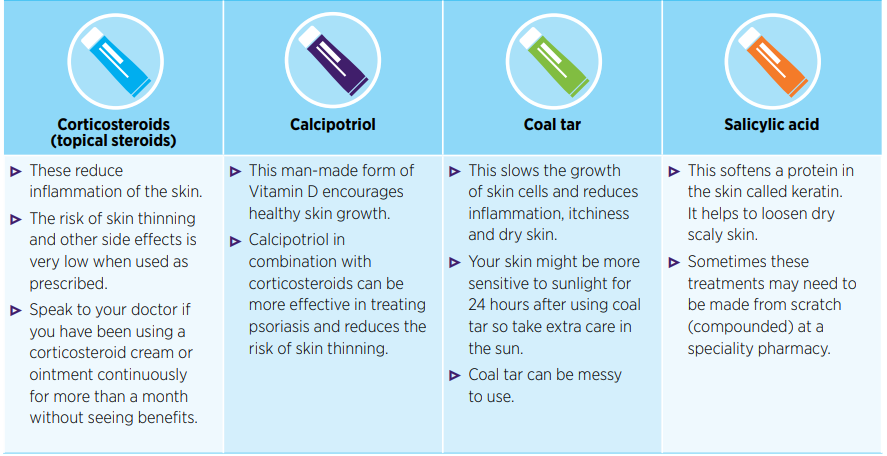Treating plaque psoriasis with creams and ointments
There are many topical treatments that can help control your plaque psoriasis. These include creams, ointments, gels, lotions, shampoos and foams. Find out how to get the most out of these treatments.
What is plaque psoriasis?
Plaque psoriasis is an autoimmune condition that affects your skin. This means your immune system attacks cells in your own body. During a flare-up you may experience raised, red or silver scaly patches, usually found on the elbows, knees, lower back and scalp. Although plaque psoriasis cannot be cured, the skin can be cleared or controlled with treatment.
How do you treat plaque psoriasis?
Plaque psoriasis flare-ups can be triggered by stress, cold weather, dry skin, upper respiratory infections or certain foods and drinks. Triggers vary from person to person, which is one of the many reasons that there is no one-size-fits-all treatment.
If you have been recently diagnosed, your doctor probably suggested you use one or several treatments such as creams or ointments on your skin – these are called topical treatments.
There are four main types of topical treatments for plaque psoriasis:

Questions to ask your doctor
People with plaque psoriasis will respond better to some topical treatments than they do to others. When you are prescribed a treatment, make sure you discuss the benefits and possible risks with your doctor. Here are some questions you could ask:
1. Why am I likely to benefit from this type of treatment?
There are many treatments for plaque psoriasis available, so it’s important to understand why this one was chosen for you.
Maybe it works well on the parts of your body affected by the condition or has the fewest side effects.
2. How much topical treatment should I apply?
Always check with your prescribing doctor how much topical treatment to use, and how thickly you should be applying it.
Ask them to compare it to the size of an object, such as a coin or a pea to make sure that you are using it correctly.
3. What do I do if I experience side effects?
If you are experiencing troublesome side effects, speak to your doctor who can discuss other options, such as another type or strength of topical treatment, phototherapy (light therapy) or other medicines.
4. How will I know whether this treatment will interact with my other medicines?
Make sure your doctor or pharmacist is aware of any medicines that you are taking for other conditions. If you don’t have a medicines list, you can print or download one from www.nps.org.au/medicineslist or use the MedicineWise app.
Visit NPS MedicineWise at nps.org.au/medicinewiseapp for more information, or download the app on your smartphone today.
5. How long do I need to use this treatment for and how do I know if it’s working?
Some treatments might be used for a short time, only when your symptoms are flaring. Other creams and ointments can be used indefinitely and in combination with other medicines your doctor prescribes. Ask your doctor or pharmacist about what you can expect from this treatment and when you should start seeing results.
Top tips
- Keep your skin moisturised to avoid irritation. Use a soap-free cleanser or wash and apply a fragrance-free moisturiser twice a day (more on cold dry days). You could apply moisturiser after a bath or shower as it absorbs better when your skin is slightly moist.
- Take extra care if you are using topical treatments on your face, genitals or in the creases of your skin. Ask your doctor for extra guidance to avoid irritation.
- Plaque psoriasis can change over time and may not always respond to the same treatment. It’s important to monitor your condition and see your doctor if you aren’t seeing improvement.
For more information
For more information on plaque psoriasis look up ‘psoriasis’ in the A–Z of skin developed by the Australasian College of Dermatologists dermcoll.edu.au/a-to-z-of-skin/.
Find detailed information about plaque psoriasis treatments on the DermNet website dermnetnz.org.
Download the original pdf of this article
Back to Plaque psoriasis hub.
